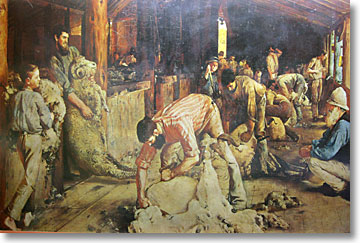
Tom Roberts painted Shearing the Rams in 1890 near Corowa
|
| The Artist Camp | 1886 (Box Hill) | |
| The Breakaway | 1891 (Corowa) | |
| The Golden Fleece | 1894 (Inverell) | |
| Bailed Up | 1895 (Inverell) | |
| The Opening of the First Federal Parliament | 1901-3 (Melbourne) | |
At least three major paints were done at Brockesby House in South Corowa.
Shearing the Rams which measures 1.2 x 1.8m was brought by the National Gallery, Melbourne in 1932.
Tom Roberts (1856-1931)
Born in England, Tom came to Melbourne in 1869 with his widowed mother and two younger siblings, Alice and Richard. They lived in Collingwood and Tom worked with a number of photographers from the age of 13 years.
Art training began when he was 15 and by 18, he worked with renowned Swiss artist, Louis Buvelot. In 1881, he went to England and Europe for overseas study (financed by the sale of paintings to the National Gallery).
Soon after returning in 1885, his balance of work started to shift from photography to painting. He had been influenced by French impressionists who tried to capture the "everchanging efects of nature" in their works. With a growing nationalist spirit that preceded Federation, Roberts joined others at Heidelberg near Melbourne and they became known as the Heidelberg school. Leaders included C. Conder, F. McCubbin, A. Streeton and later W. Withers and their efforts let to the foundation of a national school for landscape painting.
By 1890, he had completed Shearing the Rams and in 1891 painted A Breakaway at Brocklesby Station (west of Corowa). He travelled extensively between Tasmania, Melbourne, Riverina, Sydney and Torres Strait in 1890s. As well as capturing Australian life, he painted many portraits including Henry Parkes (1893).
After a long courtship and at 40 years of age, he married Elizabeth Williams (Lillie) in 1896 and settled in Balmain where they had a son Caleb.
During 1901-1903, Tom painted Opening of the First Federal Parliament. With his family, he returned to England in 1903 and stayed there for the next 16 years during which time he did many paintings and even assisted at London General Hospital with the World War I effort.
He briefly returned to Australia in 1919 and then in 1923 decided to move back permanently. He and Lillie built a house at Kallista in the Dandenongs. He had a number of exhibitions in Sydney an Melbourne with varying success.
Lillie died of respiratory failure in 1927. He was re-married in 1928 to a long time friend, Jean Boyes. Three years later and at 75 years of age, he died in June 1931 of the effects of cancer.
Tell your friends you found this at murrayriver.com.au!
Copyright Discover Murray 2025. This site or any portion of this site must not be reproduced, duplicated, copied, sold, resold, or otherwise exploited for any commercial purpose that is not expressly permitted by DISCOVER MURRAY.






 Amy Shark The Solo Acoustic "Songs & Stories" Tour
Amy Shark The Solo Acoustic "Songs & Stories" Tour Little By Little
Little By Little Lee Kernaghan Boys From The Bush The Concert
Lee Kernaghan Boys From The Bush The Concert The Australian Beach Boys Show
The Australian Beach Boys Show Kevin Bloody Wilson Aussie Icon Tour with special guest Jenny Talia
Kevin Bloody Wilson Aussie Icon Tour with special guest Jenny Talia Tom Roberts: Shearing the Rams
Tom Roberts: Shearing the Rams